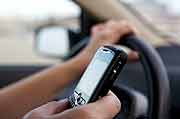
SATURDAY, May 4 (HealthDay News) — Forty-three percent of American high school students admit to texting while driving, according to a new study.
The findings show that too many teens are ignoring warnings about the risks of this dangerous habit. Research has demonstrated that texting while driving increases the risk of a crash by 23 times, and many experts say texting while driving is more dangerous than driving while intoxicated.
Researchers analyzed data from about 7,800 U.S. high school students who had their driver’s license and took part in the 2011 survey on youth behaviors conducted yearly by the U.S. Centers for Disease Control and Prevention. The teens were asked if they had texted while driving in the past 30 days, and 43 percent said they had.
Males were more likely to text while driving than females — 46 percent versus 40 percent, respectively. The likelihood of texting while driving increased with age: 52 percent of those over age 18, 46 percent of 17-year-olds, 33 percent of 16-year-olds and 26 percent of 15-year-olds.
The study also found that teens who texted while driving were more likely to engage in other risky behaviors, such as drinking and driving, having unprotected sex, and using indoor tanning devices.
“By identifying associated high-risk behaviors such as these, it is our hope that we can develop more effective mechanisms to reduce texting while driving,” principal investigator Alexandra Bailin, a research assistant at Cohen Children’s Medical Center of New York, said in an American Academy of Pediatrics news release.
Bailin and her colleagues also found that state laws banning texting while driving had little effect. Thirty-nine percent of teens reported texting and driving in states where it is illegal, compared with 44 percent of teens in states with no restrictions, according to the study, which is scheduled for Saturday presentation at the Pediatric Academic Societies’ annual meeting in Washington, D.C.
Because this study was presented at a medical meeting, the data and conclusions should be viewed as preliminary until published in a peer-reviewed journal.
“Although teens may be developmentally predisposed to engage in risk-taking behavior, reducing the prevalence of texting while driving is an obvious and important way to ensure the health and safety of teen drivers, their passengers and the surrounding public,” Bailin said.
More information
The U.S. National Highway Traffic Safety Administration has more about distracted driving.

